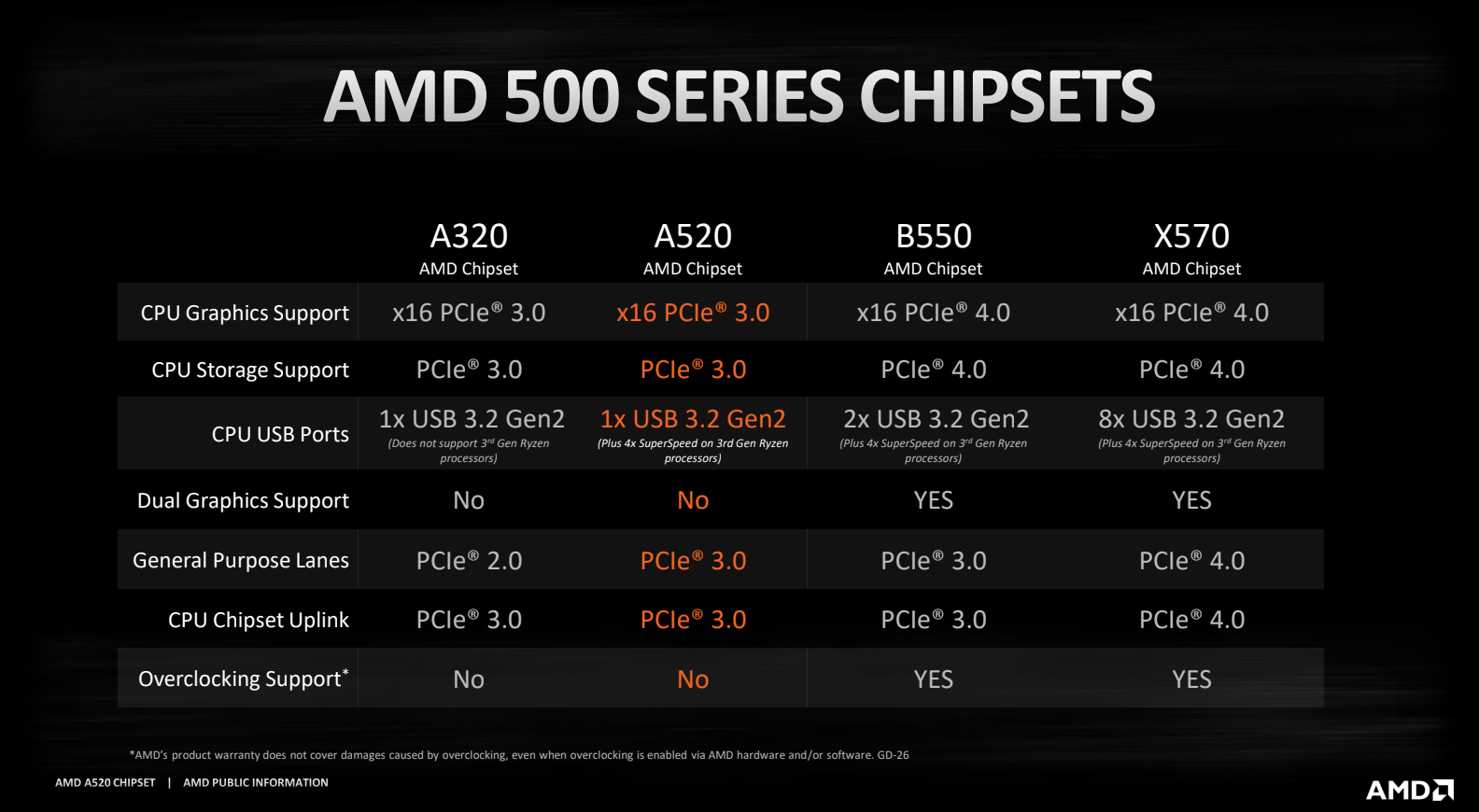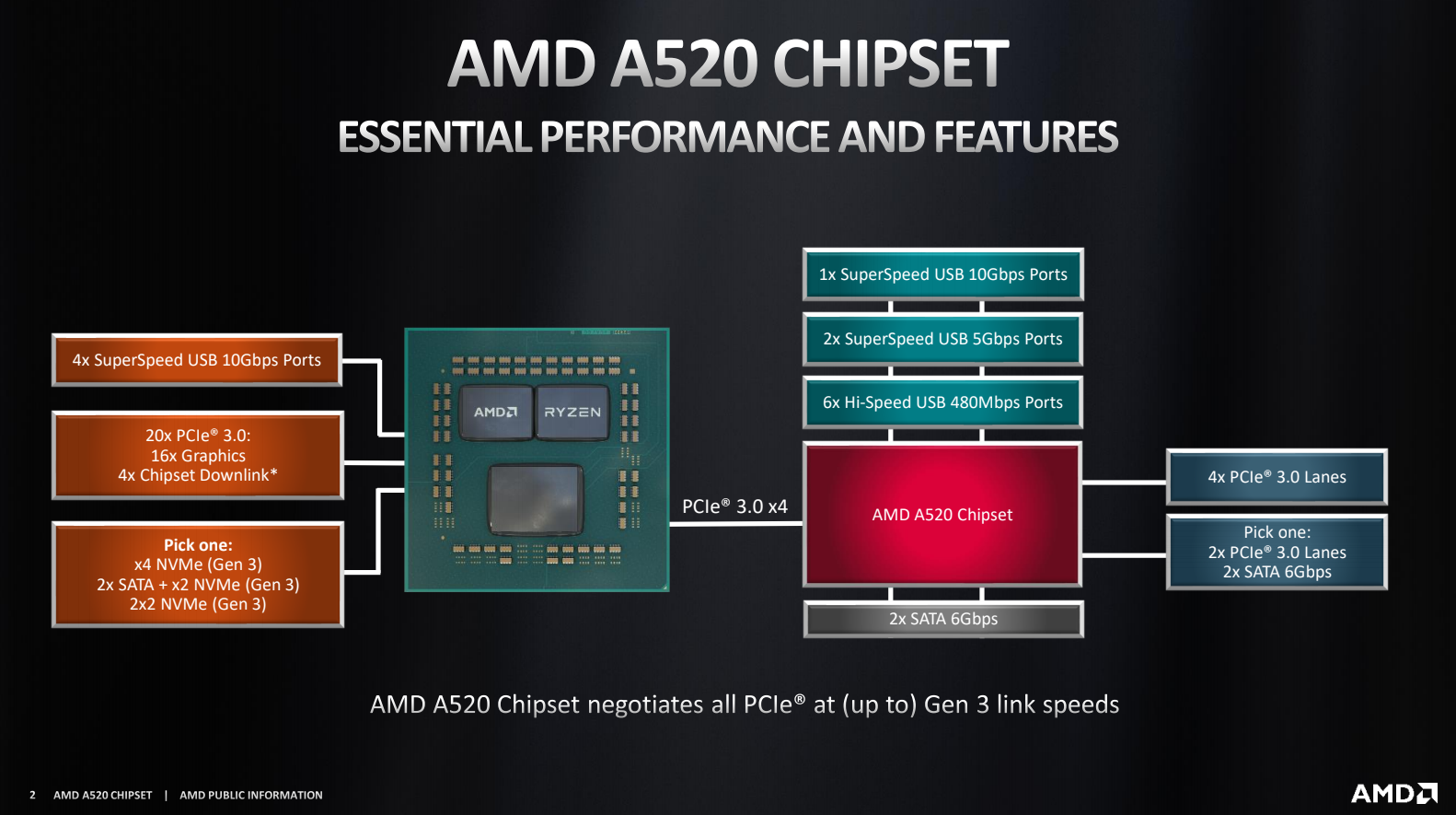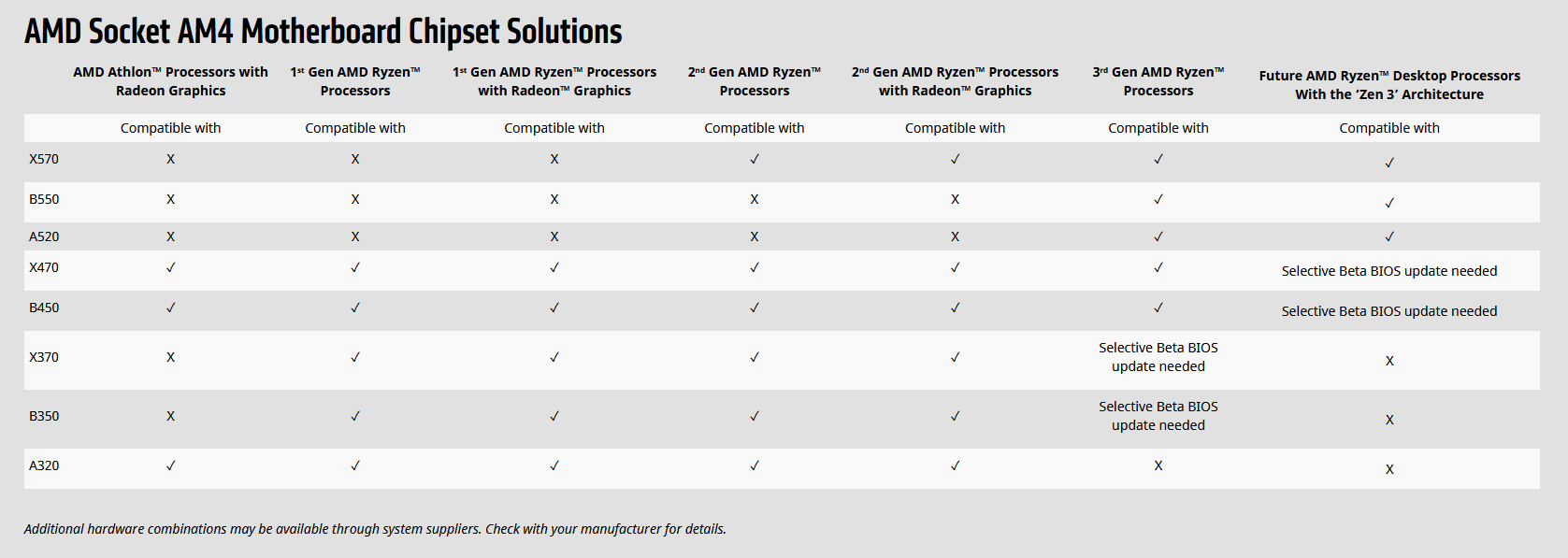AMD today announced its A520 chipset, following-up the previous B550 and X570 launches, and excluding the B550A chipset (which was a rebranded B450 chipset). The A520 chipset is nearly identical to the A320 chipset from 2017, except some items move to PCIe Gen 3 from PCIe Gen 2. We’ll recap the chipset differences again here today, although if you want full comparative details between X570, B550, the 400-series, and the 300-series, we’ll refer you to our recent AMD Chispet Differences content here. For this one, we’re focusing on just the A520 chipset.
AMD Chipsets As of Now
If you’d forgotten, AMD originally launched Ryzen with A320, X300, and A/B300 at the low-end. The last 3 might not sound familiar, because they basically stopped getting marketed: You can technically run Ryzen CPUs without a chipset, and the X300 part was targeted toward boards that were intended to be so small that there was no space for a separate chipset component.
The A320 chipset was among the cheapest available to DIY users and has persisted unreplaced until now. You can expect A520 on low-end motherboards, particularly those in the sub-$100 range. These parts will be available through motherboard manufacturers immediately, both to DIY and to OEM markets.
AMD A520 Chipset Specs
Getting straight into the specs, it’s pretty simple: AMD highlights A520 as only upgrading a few points. The CPU USB support is expanded for 3000-series Ryzen CPUs, marked in small text below the 1x USB 3.2 Gen2 text, and nothing else changes here. It does not offer any additional USB ports beyond these; at least, not without using some of the general purpose PCIe lanes to do it. The board upgrades its general purpose lanes from PCIe 2.x to PCIe Gen3 as one of the primary changes.
Compared to B550, the largest difference is support of PCIe Gen4 for PEG (or PCIe Graphics) and for CPU storage. If you’re uncertain whether that matters for you, for the most part, the answer as of right now, today, is that it isn’t likely. PCIe Gen4 mostly becomes valuable for storage compatibility, while providing mostly no value beyond marketing for graphics. That’s very possible to change when the RTX 3000 series comes out in about a month, though, so keep that in mind if buying past when this content goes up.
For the rest, the next biggest change is the lack of overclocking support. Overclocking is locked on the A520 motherboards.
AMD A520 Chipset Block Diagram
AMD also sent this block diagram to illustrate things. The CPU support doesn’t change, since that’s baked into the CPU, and is represented on the far left side. The link to the chipset is Gen3 both ways, as it is on B550, and the USB options are listed above the chipset. As long as the lanes add up to the same total count, where higher speed IO costs more lanes, your motherboard maker can configure one of these options. AMD has done us all the favor of using speed ratings here, rather than the USB-IF’s horrible naming scheme.
2x SATA 6Gbps ports are also supported off of the chipset, alongside 4 additional PCIe Gen3 lanes, maybe useful for a capture card or other accessory, and a choice of 2x SATA 6Gbps or 2x PCIe 3 lanes.
AMD A520 Chipset Specs vs. B550, X570, A320, etc.
Back to our previous chart of chipset differences, B550 gets you extra lanes basically down the entire I/O listing. Usable PCIe Gen3 lanes go up to 10 on B550, with options to reconfigure to SATA as needed. As a reminder, this doesn’t mean you get the option to reconfigure them -- it’s down to how the motherboard maker routes things on a per-design basis.
AMD Chipset Specs & Comparison (2020) | GamersNexus.net | ||||||||
| Chipset | X570 | B550 | X470 | B450 | X370 | B350 | A520 | A320 |
| Officially Supports (some boards may expand support) | Zen 3** (*so far; *no 3000 APU support) | Zen 3** (*so far; *no 3000 APU support) | Zen 2, Sometimes Zen 3 | Zen 2, Sometimes Zen 3 | Zen+, (incl. 3000 APUs) sometimes Zen2 | Zen+, (incl. 3000 APUs) sometimes Zen2 | Zen 3 of some kind Ryzen 3000 DT CPUs | Zen+, (incl. 3000 APUs) sometimes Zen2 |
| Chipset Link | PCIe 4.0 x4 | PCIe 3.0 x4 | PCIe 3.0 x4 | PCIe 3.0 x4 | PCIe 3.0 x4 | PCIe 3.0 x4 | PCIe 3.0 x4 | PCIe 3.0 x4 |
| Usable PCIe Gen 4 | 16(8 reconfigurable as groups of 4 for 4x SATA or x4 NVMe) | 0 | 0 | 0 | 0 | 0 | 0 | 0 |
| Usable PCIe Gen 3 | 0 | 10(2 reconfigurable as SATA) | 0 | 0 | 0 | 0 | 6(2 reconfigurable as SATA) | 0 |
| Usable PCIe Gen 2 | 0 | 0 | 8 | 6 | 8 | 6 | 0 | 4 |
| SATA III (6Gbps) | 4 | 4 | 4 | 2 | 4 | 2 | 2 | 2 |
| SATA Express | 0 | 0 | 2x(or 4x SATA) (or x4 NVMe Gen 3) | 2x(or 4x SATA) (or x4 NVMe Gen 3) | 2x(or 4x SATA) (or x4 NVMe Gen 3) | 2x(or 4x SATA) (or x4 NVMe Gen 3) | 0 | 2x(or 4x SATA) (or x4 NVMe Gen 3) |
| USB 10Gbps | 8 | 2 | 2 | 2 | 2 | 2 | 1 | 1 |
| USB 5Gbps | 0 | 2 | 6 | 2 | 6 | 2 | 2 | 2 |
| USB 480Mbps | 4 | 6 | 6 | 6 | 6 | 6 | 6 | 6 |
Finally, here’s the more technical representation of AMD’s graphic. No new information here, really, just that there are 6 usable PCIe Gen 3 lanes, whereas B550 runs 10 and X570 runs 0, but picks up 16 PCIe Gen 4 lanes. A520 doesn’t have enough total lanes to run multiple GPUs in an official capacity, as NVIDIA requires x8 for SLI and AMD needs more than it’ll get here to operate well. Overall, this is an upgrade not only in bandwidth on A520 versus A320, but also in usable PCIe general purpose lane count, where A320 was running 4 PCIe Gen2 lanes.
AMD 4000-Series APUs & Zen 3 CPU Support Notes
As a reminder, AMD also told us at the announcement of its 4000-series APUs, which are Zen 2 parts, that it would eventually be releasing some form of 4000-series APU (codenamed “Renoir”) to DIY enthusiast. It looks like AMD is pushing to get the final run of its pre-Zen 3 products out now, with A520 preempting that eventual and officially promised launch.
A520 is really meant for ultra-budget builds for things like small office PCs or similar systems. Overclocking is a high value add for Ryzen, so if affordable, we’d recommend B450 or B550 rather than A520 -- but if you don’t need the extra features, A520 may be suitable for office PC types of setups.
One final important note: AMD explicitly mentioned “planned support for future Ryzen desktop processors based on the Zen 3 architecture,” recommitting to its previously controversial Zen 3 support changes. On the AMD website, support for A520 is listed as present for Ryzen 3000 desktop CPUs and Zen 3 CPUs, with no distinction over whether it’d be an APU or CPU. Ryzen 1000 CPUs, Athlon APUs, and Ryzen 2000 CPUs are explicitly listed as unsupported by AMD, although sometimes things kind of work when they shouldn’t, so who knows. Officially, though, there’s no support for those products.
Editorial, Host: Steve Burke
Video: Keegan Gallick, Andrew Coleman


